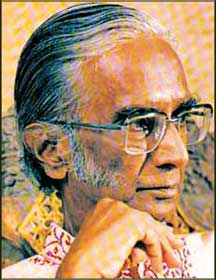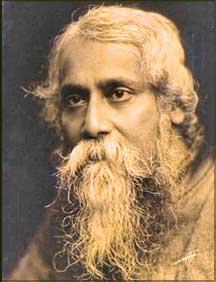Tagore and Indo-Lanka cultural links
D.C.R.A. Goonetilleke
When we refer to the interaction of India and Sri Lanka in whatever
field, we assume that India and Sri Lanka are two separate countries,
but there was a time in the distant past when India and Sri Lanka were a
single land mass. Even today after the land mass has split, the distance
between India and Sri Lanka is only 22 miles. That is the full distance
of the Palk Strait.

Prof. Ediriwira Sarachchandra |

Rabindranath Tagore |
In earlier ages when transport and communications between countries
and contacts were minimal, the only significant foreign impact on Sri
Lanka was that of India. Of course, everybody knows that the greatest
gift to Sri Lanka, made by India, is Buddhism. The religion, which
originated in India but was superseded there by Hinduism and Islam, was
brought across to Sri Lanka in the 3rd century B.C. by Ven. Mahinda, the
son of Emperor Asoka of India, who founded the order of monks here. He
was followed by his sister Sanghamitta Theri, who founded the order of
Buddhist nuns here. The arrival of Ven. Mahinda in the 3rd century B.C.
is recorded in the Mahavamsa, the Great Chronicle, and substantiated by
a rock inscription after his passing away, found in Amparai.
Sanskrit literature
Buddhism is the fountainhead of Sinhalese literature. Pali texts
brought by Ven. Mahinda were translated to Sinhalese and designated the
Hela Atuva. These texts were translated back into Pali by Ven.
Buddhagosha (et. al), who came from India in the 5th century. The
Sinhala texts disappeared or were destroyed, and Pali became the
official language of Buddhism. The earliest extant prose works of
importance in Sinhalese date from the 13th century and were pietistic -
the Amavatura of Gurulugomi, the Butsarana of Vidyachakravarti.
Of special significance for the development of the short story were
Dharmasena Thera's 13th-century Saddharma Ratnavaliya and
Saddharmalankaraya (1398-1410) by Dharmakirthi Thera II, based on
earlier Pali texts. It has been observed that the Saddharma Ratnavaliya
and the Saddharmalankaraya combine an ever present moral and religious
didacticism with a surprisingly rich, earthy yet subtle vein of
psychological exploration dealing with emotional impulses and social
pressures that govern daily life.
The Jataka tales (stories of the past lives of the Buddha) which were
recorded in the 14th century and were popularized by monks who used
these to illustrate their sermons, form a part of a popular oral
tradition. These contained the rudiments of fiction which influenced the
rise of Sinhalese fiction as from the late 19th century, as well as
stimulated later literary works.
The Sinhalese during the long years before the impact of Western
literary criticism were indebted exclusively to India, to Sanskrit in
particular, for literary touchstones - for ideas as to what constitutes
literature, for ideas as to how to appreciate and evaluate literature.
The touchstones include alankara (embellishment, decoration), shailya
(style), reethi (rules, standards), guna (inherent quality), vakrokti
(indirection, obliqueness), rasa, auchitya (suitability,
appropriateness) and dvani (denotation and connotation).
In the 9th century, King Sena's Siyabaslakara was more or less a
translation of Dandin's earlier Sanskrit work Kavyadarsha which
discussed general issues and poetic figures. Sri Lanka also inherited
literary forms from India. Sanskrit drama was, probably, read but was
never performed and did not provide a stimulus to local playwrights. On
the other hand, Kalidasa's Mega Dutha or Cloud Messenger inspired a
whole host of Sinhalese Sandesa or message poems such as the Mayura
Sandesaya (the Peacock Messenger Poem) and the Tisara Sandesaya (the
Swan Messenger Poem). It is interesting to note that among the Sigiri
Graffiti is a Sanskrit sloka written by a visitor from India called
Vajira Varman, responding to the frescoes.
Religious spirit
It is interesting to note that Sanskrit was not only a seminal
influence on the arts in Sri Lanka but that Sri Lanka made a
contribution to Sanskrit literature itself by means of a poem named the
Janaki harana which has for its subject the story of the Ramayana.
Manuscripts of the poem found in the 1950s in Malabar proved that the
poet of the Janaki harana was indeed named Kumaradasa. He was not a king
but a scion of the Sinhalese royal family, the son of a prince named
Manita. Tamil literature in Sri Lanka lay in the shadow of South India
for a very long time, and a distinctively Sri Lankan kind of Tamil
literature was unable to emerge until the 17th century. As purist
scholars on both sides of the Palk Strait endeavoured to follow a South
Indian and Sanskrit tradition, the first Sri Lankan Tamil literary works
were written in a religious spirit, the spirit of Hinduism which was
another great gift from India.
Christian missionaries
These were confined to commentaries on the ancient classics, tedious
and conventional. The first spark occurred in the late 19th century as a
consequence of religious zeal and conflict. Christian missionaries
sought to proselytize by preaching in the native language, and they
enlisted traditional poetic forms to express Christian themes. On the
other hand, to combat the inroads of missionaries, Hindu poets created
works which explicated and exalted their own religion. This literature
too was of a didactic sort.
The South Indian film and dance forms like Bharata Natyam, Kathak and
Kathakali continue to exert a potent influence on Tamil mass
entertainment and art in Sri Lanka, but the winds of change in Sri Lanka
in the 1950s made a deep impact on Tamil writing - fiction, poetry and
drama - and brought about a Tamil literature that broke free from South
Indian literature and assumed a distinctively Sri Lankan identity. Tamil
writing became irrevocably secular and popular in character.
Nevertheless the South Indian influence was a catalyst. It should also
be observed that dance forms like Bharata Natyam, Kathak and Kathakali
have interested Sinhalese performers and audiences.
In the 20th century, among the Indian individuals who exerted an
influence on Sri Lankan culture, the greatest was Rabindranath Tagore.
He is the only Indian to win the Nobel Prize for Literature, a hallmark
of world recognition, and the creator of the song in Bengali which was
adopted as the national anthem. In his Bengali essays, Tagore stresses
that the Bengali word for literature, 'sahitya', derives from 'sahit'
and etymologically means together or intimacy. Tagore was not
chauvinistic.
He emphasized that an India, bereft of Western contact, would have
been wanting in an essential element in her quest for fulfilment. Like
Jawaharlal Nehru in The Discovery of India, Tagore believed that the
greatest blessing of British rule was that it enabled the heterogeneous
country that was India to rise in a single voice, the Indian voice.
Tagore expresses his view of freedom:
Where the mind is free,
and the head is held high,
where knowledge is free;
Where the world has not been broken up
into fragments by narrow domestic walls.
Tagore seems to me the quintessential Indian.
As commonly in ex-colonies, the presence of the colonial 'masters'
had a suffocating effect on the creative energies of the local
inhabitants in Sri Lanka and the emergence of Sri Lankan English
literature flows from the growth of nationalist currents. This growth
was stimulated by the freedom struggle in India and by certain
remarkable Indians who were active in that period.
Cultural heritage
In the 1930s and early 1940s, the Kandy Lake poets were inspired by
Indian poets such as Tagore and Sarojini Naidu. R. K. Narayan's success
in the West is likely to have stimulated Jinadasa Vijayatunga. D.F.
Karaka was a household word in Sri Lanka at that time; his fiction and
non-fiction would have acted as a stimulus to local writing. S.W.R.D.
Bandaranaike attended a performance of Tagore's Saapmochan which Tagore
himself staged in Colombo during a visit to Sri Lanka in 1934, and
Bandaranaike wrote in his review (which included a quotation from
Sarojini Naidu's poetry): India has as good a reason to be proud of
Tagore as of Gandhi; for he has made an original contribution to art
which can stand the test of comparison with anything of the kind the
West has evolved.
Ediriwira Sarachchandra (1914-1996), a remarkable bilingual, became
the pre-eminent man of letters in Sinhala as well as the leading
novelist in English.
To be continued
|



